The AMD Ryzen 3 1300X and Ryzen 3 1200 CPU Review: Zen on a Budget
by Ian Cutress on July 27, 2017 9:30 AM EST- Posted in
- CPUs
- AMD
- Zen
- Ryzen
- Ryzen 3
- Ryzen 3 1300X
- Ryzen 3 1200
Grand Theft Auto
The highly anticipated iteration of the Grand Theft Auto franchise hit the shelves on April 14th 2015, with both AMD and NVIDIA in tow to help optimize the title. GTA doesn’t provide graphical presets, but opens up the options to users and extends the boundaries by pushing even the hardest systems to the limit using Rockstar’s Advanced Game Engine under DirectX 11. Whether the user is flying high in the mountains with long draw distances or dealing with assorted trash in the city, when cranked up to maximum it creates stunning visuals but hard work for both the CPU and the GPU.
For our test we have scripted a version of the in-game benchmark. The in-game benchmark consists of five scenarios: four short panning shots with varying lighting and weather effects, and a fifth action sequence that lasts around 90 seconds. We use only the final part of the benchmark, which combines a flight scene in a jet followed by an inner city drive-by through several intersections followed by ramming a tanker that explodes, causing other cars to explode as well. This is a mix of distance rendering followed by a detailed near-rendering action sequence, and the title thankfully spits out frame time data.
There are no presets for the graphics options on GTA, allowing the user to adjust options such as population density and distance scaling on sliders, but others such as texture/shadow/shader/water quality from Low to Very High. Other options include MSAA, soft shadows, post effects, shadow resolution and extended draw distance options. There is a handy option at the top which shows how much video memory the options are expected to consume, with obvious repercussions if a user requests more video memory than is present on the card (although there’s no obvious indication if you have a low end GPU with lots of GPU memory, like an R7 240 4GB).
To that end, we run the benchmark at 1920x1080 using an average of Very High on the settings, and also at 4K using High on most of them. We take the average results of four runs, reporting frame rate averages, 99th percentiles, and our time under analysis.
For all our results, we show the average frame rate at 1080p first. Mouse over the other graphs underneath to see 99th percentile frame rates and 'Time Under' graphs, as well as results for other resolutions. All of our benchmark results can also be found in our benchmark engine, Bench.
MSI GTX 1080 Gaming 8G Performance
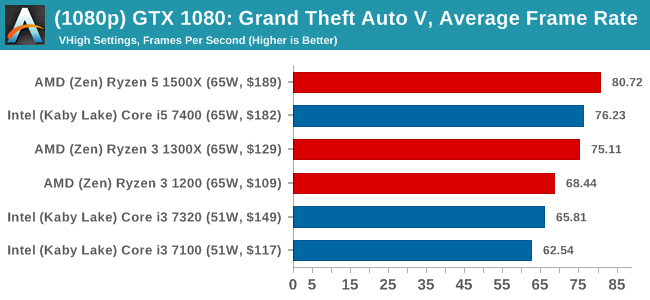
1080p

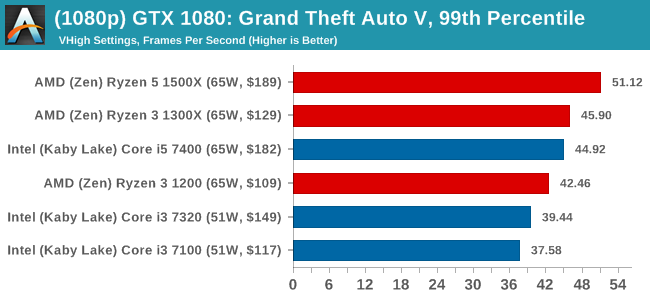
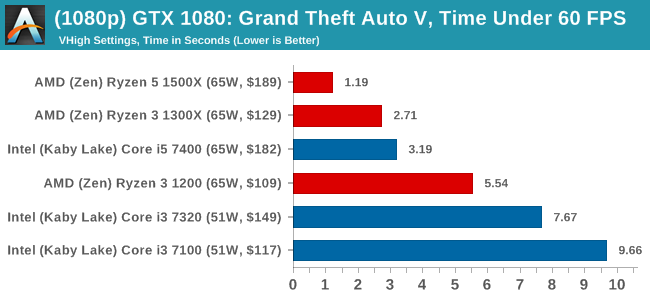
4K
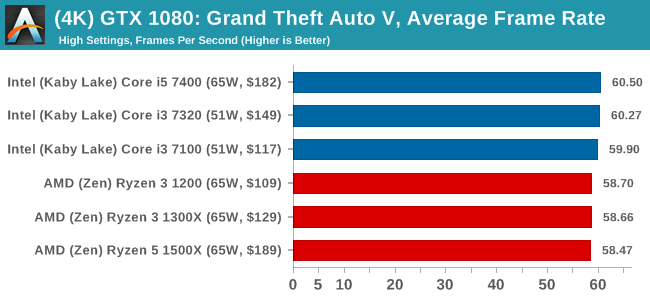
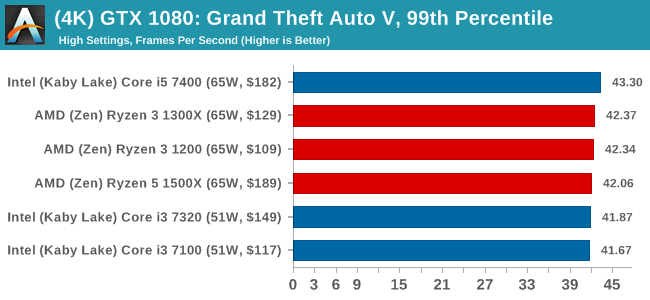
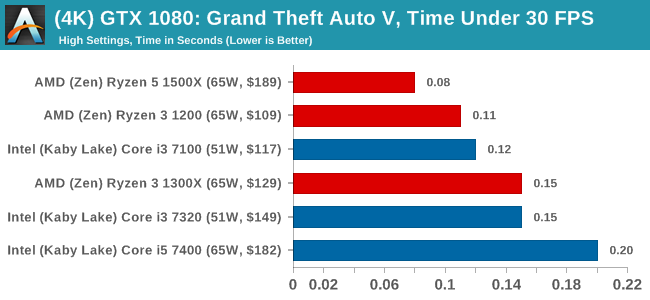
ASUS GTX 1060 Strix 6GB Performance
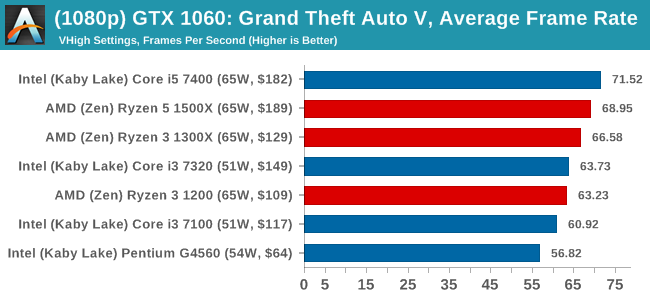
1080p

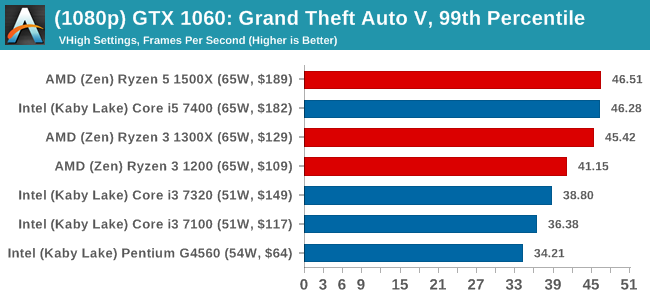
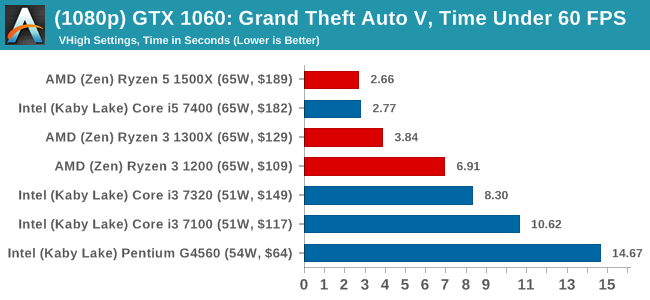
4K
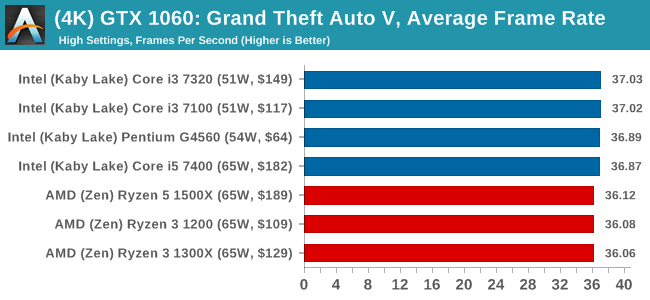

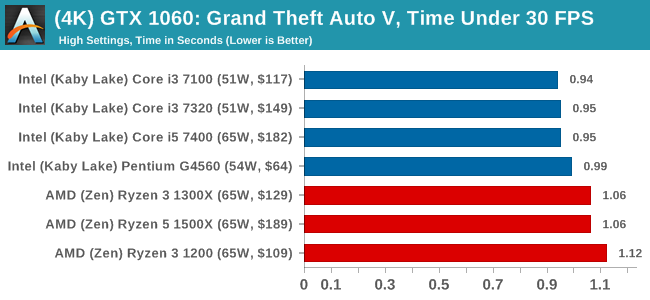
Sapphire R9 Fury 4GB Performance
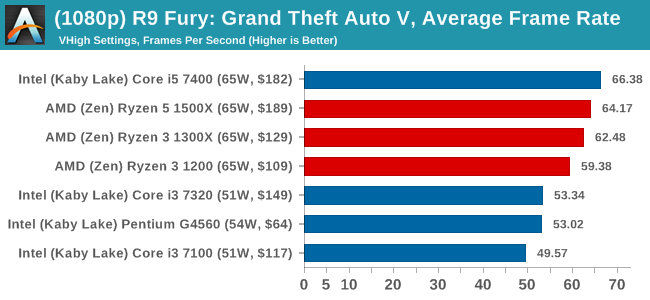
1080p

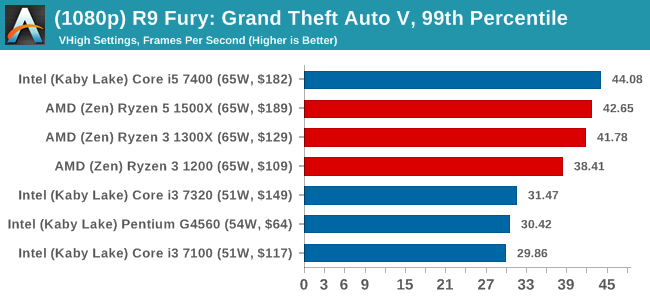
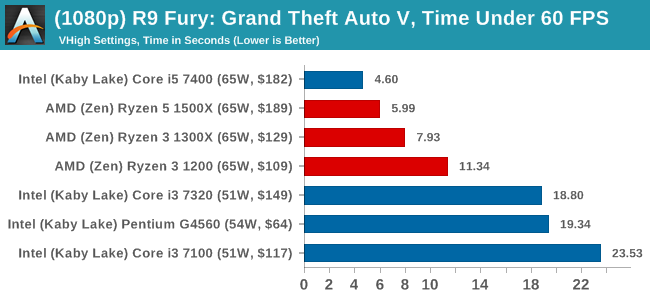
4K
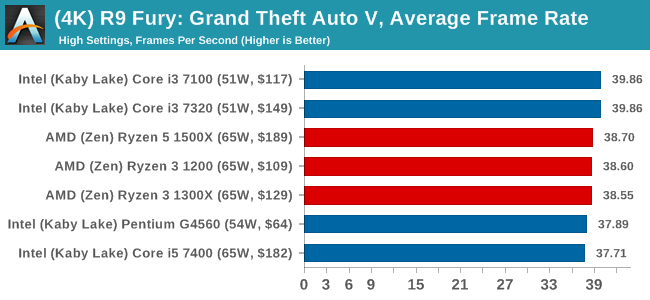
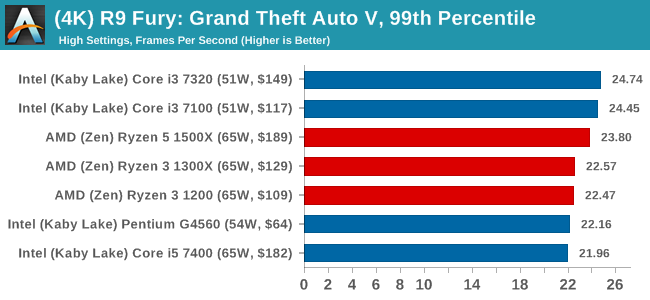

Sapphire RX 480 8GB Performance
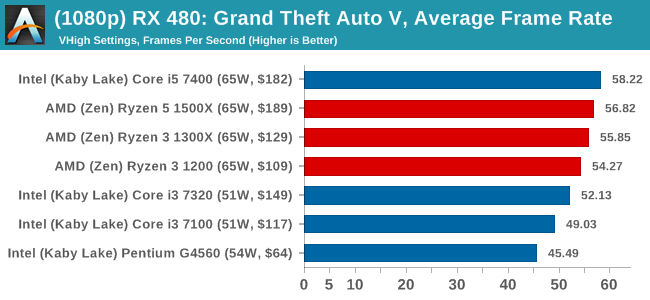
1080p

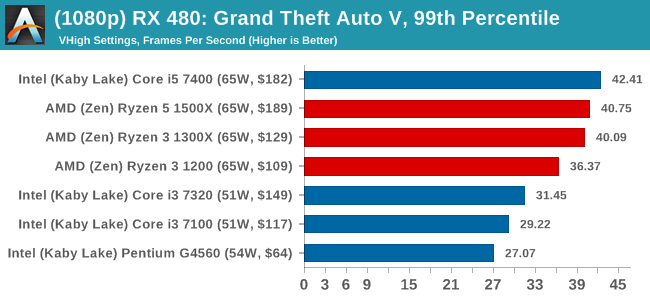
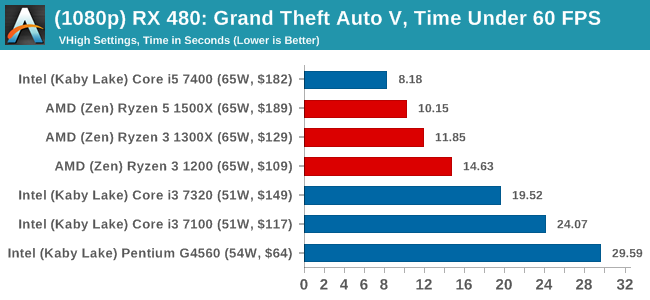
4K
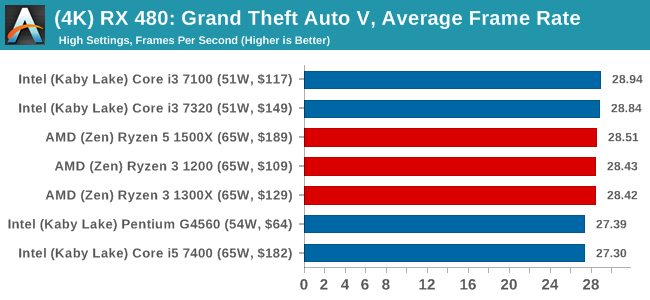
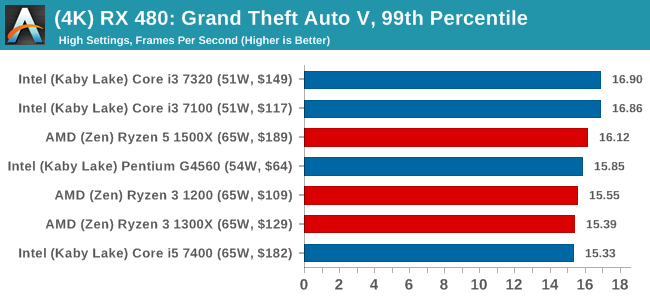
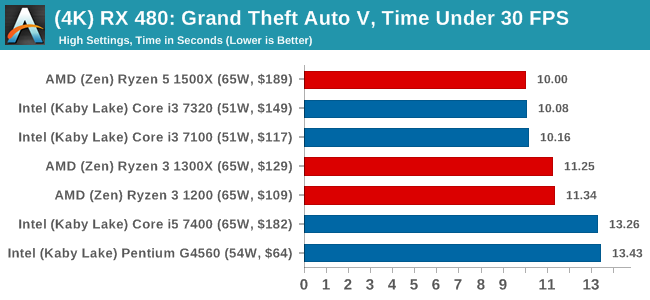













140 Comments
View All Comments
haukionkannel - Thursday, July 27, 2017 - link
You can install Ryzen 1200 and use Nvidia 1080ti and run games at 4K easily, so there is a point of these prosessors.There will be Ryzen based APU later in this or next year for Office computers and maybe even htpc usage and laptops. Those Are budget CPU for gaming and you can pair them as fast GPU as you like and still get reasonable good results!
The Intel 7700 is in the top, but if you run games at 4K I think that you can save a big deal by usin amd 1200 instead of Intel 7700! The difference is so small in speed and so big in money!
kaesden - Thursday, July 27, 2017 - link
dont forget that ryzen 1200 with a 1080ti could also have a 1700 dropped in down the line when budget allows, or when more cpu performance is needed. And the ryzen based APU's are coming eventually for those who just want basic integrated graphics. AMD isn't finished yet with their roll out.zodiacfml - Thursday, July 27, 2017 - link
The purpose is to make use/sell of disabled chips. This could be the reason why AMD and Nvidia started selling the new, lowest end discrete graphics cards. Desktop APUs will arrive early 2018.I wonder if AMD will ever have to cripple these Zen parts in the future as some articles mention they have high pretty good wields.
lefty2 - Thursday, July 27, 2017 - link
They aren't "making" a $100 CPU with no iGPU, they are just re-badging a $500 CPU. Much cheaper in research costs than having to design a new die. ...and the same logic applies to the 7700Kbennyg - Thursday, July 27, 2017 - link
I think the price/perf discussion should be a it broader in scope than just comparing CPU alone. The need to find or buy a GPU for the R3 compared to the Intel competition is a noticable omisson. Even the budgestest secondhandest GPUs will throw out the metrics of a $30 price comparison, but the extra graphics performance and/or features you may get from a dedicated GPU over iGPU should also be considered.bennyg - Thursday, July 27, 2017 - link
should be a *lot* broader. typoManch - Friday, July 28, 2017 - link
That's why these were tested with the higher end GPU's. To eliminate the IGP as a performance factor and compare CPU only. As you said, the extra performance you would get from even a low end discrete would be an unfair advantage for AMD. If you got one that was crappier than the IGP(if possible) then it would be an unfair advantage to Intel. It would be hard to decide which Discrete card would be the official stand in. On that note, doesn't AMD have discrete R7 cards that are paired with their APU's that are pretty much a copy of the IGP? They're not VEGA cores though so it wouldn't be a good way to predict the performance of the upcoming APU's. It would however give an idea as to what Bristol would have been using ZEN cores.extide - Saturday, July 29, 2017 - link
Latest AMD APU's are still construction cores (Excavator) with Polaris based graphics. Ryzen with Vega based will come later.Alexvrb - Thursday, July 27, 2017 - link
I don't know... maybe... gaming on a relatively small budget? Ryzen 3 plus a $150-200 graphics card is clearly better than an equivalent i3 build, plus they overclock even with a cheap B350 board.serendip - Friday, July 28, 2017 - link
For a cheapo gamer like me, Ryzen 3 + a $100 card is fine, but how big is that market anyway?AMD needs to go beyond servicing enthusiasts, it has to get OEMs to use Ryzen in cheap PCs for basic use in schools, homes and businesses. These segments won't bother going for Ryzen 5 or i5, they just want the cheapest computer available. AMD doesn't have a good name in the low end of the market because of its terrible APUs.